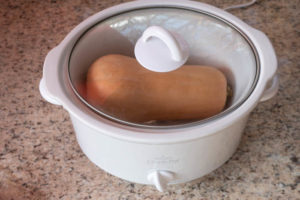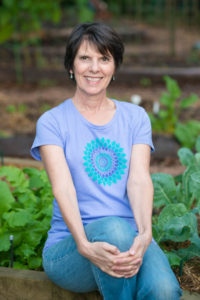Time for Greens and Pomegranates
Your December garden checklist is here and ‘tis the season for fresh broccoli, cauliflower, hearty greens, delicious citrus…and pomegranates!

Hold a pomegranate half, seed side down, over a bowl and whack it several times to remove seeds.
It’s hard to resist the beautiful pomegranates available this time of year. The ruby red arils add a pop of color and a little tangy sweetness to salads, pilafs, or even sprinkled atop a dish of Christmas guacamole. If you’ve been to the grocery store lately, you’ve undoubtedly noticed pomegranates prominently displayed in the produce section. Or perhaps you are lucky enough to have your own tree.
The exotic nature of the pomegranate can be a bit confounding when it’s time to liberate those juicy seeds. A long-time recommendation is to cut the pomegranate in half or quarters and turn them inside out into a bowl of water to release the seeds. But there’s an easier way – paddle your pomegranate! Cut the pomegranate in half and hold it over a wide bowl, cup it upside down in your hand and whack it – again and again – with a sturdy spoon. The arils pop right out and fall into the bowl. Here is a helpful video demonstration from Jamie Oliver.
Drier Weather = More Irrigating
Summer just didn’t want to let go this year but finally we are in the zone for cool season gardening. November brought mild and sunny days followed by cool and comfortable nights. These blissful days almost make me forget that we haven’t had significant rain lately, so be sure to put irrigating on your December garden checklist. An inch of water per week, enough to wet the soil 3-4 inches below the surface, should be sufficient.
The average first frost for Central Texas usually hits in early December. However, weather forecasters say that we are in a La Niña cycle which means that winter will likely be warmer and drier than normal. One of the local meteorologists is even calling for shorts and flip flops for Christmas! Of course, the possibility of freezes still exists but hopefully we will avoid freezing temperatures that are cold enough to damage unprotected hoses, pipes and plants.
December Garden Checklist
Here is the vegetable gardener’s checklist for December:
Fertilize
- Fertilize vegetables in containers with a water-soluble fertilizer and spread a layer of leaves or mulch over the soil surface.
Water
- Continue to irrigate vegetables during dry periods. Monitor even if you get a little rain.
Plant
- Mid-month is a good time to seed broccoli, cabbage, cauliflower, Swiss chard and spinach indoors under grow lights so they will be ready for transplanting in January. It takes about 6 weeks to grow a good-sized transplant.
- Dixondale Farms is a family-owned, 100-year-old Texas company that specializes in onion transplants. Check out their onion varieties at the Dixondale Farms website (www.dixondalefarms.com) and order transplants for setting out in January. Short day varieties, including ‘Texas Legend’ and ‘1015Y’, grow best in Central Texas gardens.
Soil
- Use mild days to turn compost and add mulch where needed. Try to use looser mulches that allow rainwater to reach the soil or pull the material to the edge of the plant drip line.
Harvest
- Keep lettuce, collards, kale and other greens growing all winter by harvesting leaves from the outer perimeter of the plant so that the crown remains intact and the inner portion of the plant will continue growing. Alternatively, the entire plant can be harvested once the leaves have reached their mature size.
- After cutting your first head of broccoli, leave the plants in the ground and they will continue to produce delicious side shoots.

After cutting your first head of broccoli, leave the plants in the ground and they will continue to produce delicious side shoots.
- Cut or twist the leafy tops off of turnips, beets, radishes and carrots before storing and don’t overlook the culinary potential of those leafy greens. They are totally edible and nutritious, and their pungent bite is tempered when chopped up and incorporated into soups, casseroles, vegetable sautés or dips.
Maintenance
- Seed catalogs for 2021 should be arriving soon. Inventory your seed supply and order new varieties for the upcoming spring season.
- Take advantage of December’s slower pace to organize garden supplies, clean tools, wash gloves, chunk the junk and repurpose, repair or recycle unused garden gear. If needed take equipment such as tillers, trimmers or mowers in for maintenance or repairs.
- Evaluate your garden successes and failures of the past year. Think about changes or improvements you need to make for 2021.
Enjoy!

Cook whole butternut and other winter squashes in a slow-cooker when a recipe calls for mashed or puréed squash.
- Try the hands-off version of cooking smaller-sized winter squash in a slow cooker. Place a washed, uncut squash, such as butternut or kabocha, in the slow cooker. Cook on low for 6-8 hours, cool slightly, then scoop out seeds, scrape flesh from skin and mash or purée.
- Be sure to eat a hearty bowl of black-eyed peas (for good luck) and collard greens (for prosperity) on New Year’s Day. Let’s hope that 2021 will finally bring an end to COVID-related isolation.
Additional Resources
Recommended Vegetable Varieties for Travis County
Sustainable Food Center Farmers Markets
Monthly Gardening Calendar for Austin and Central Texas

